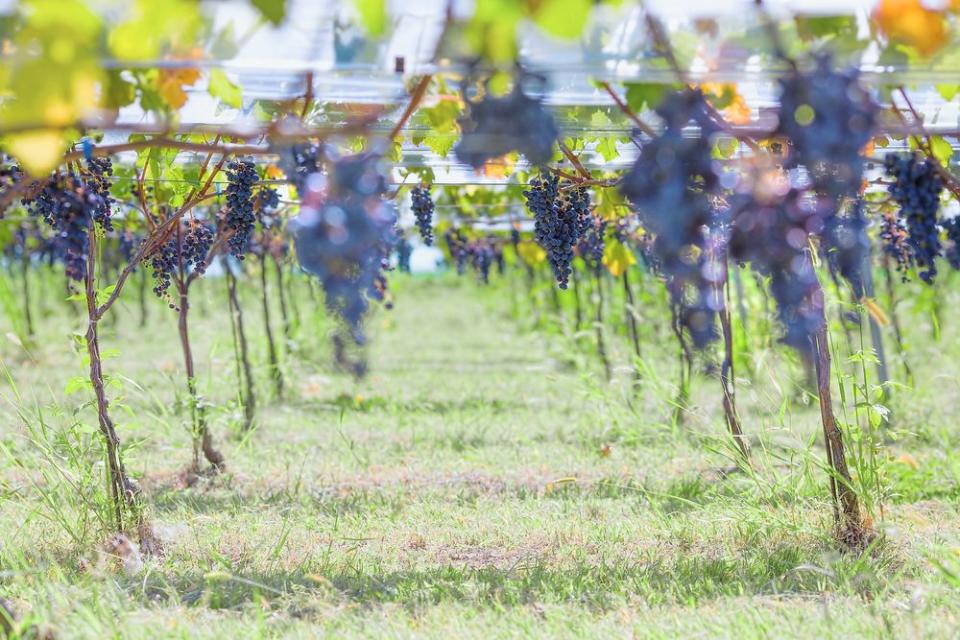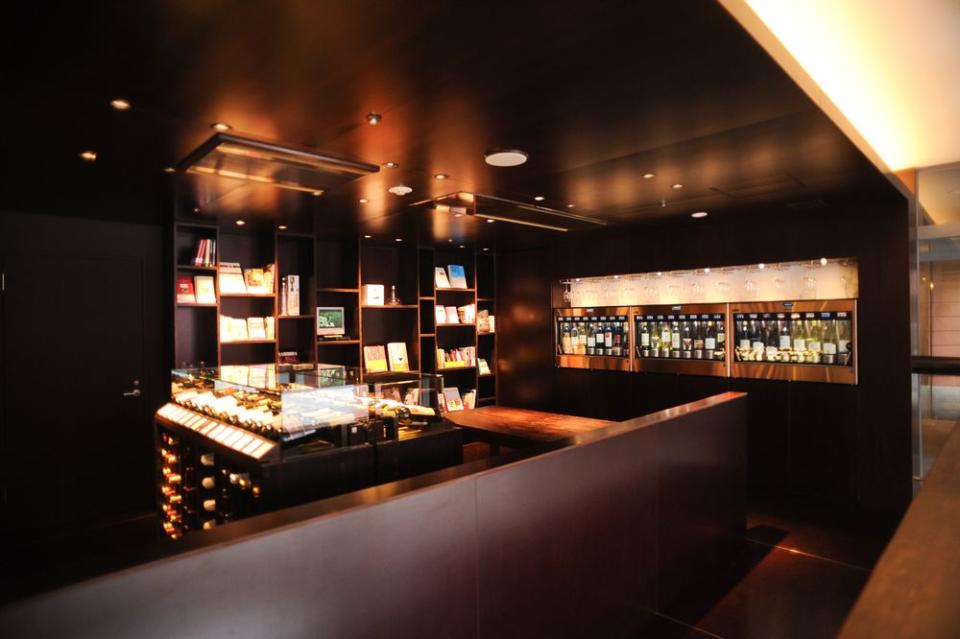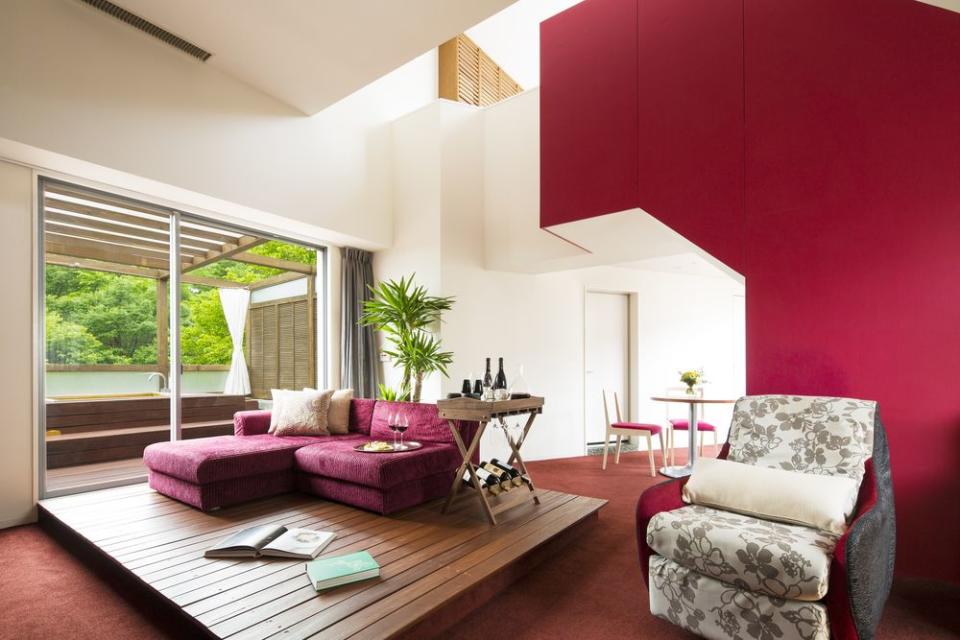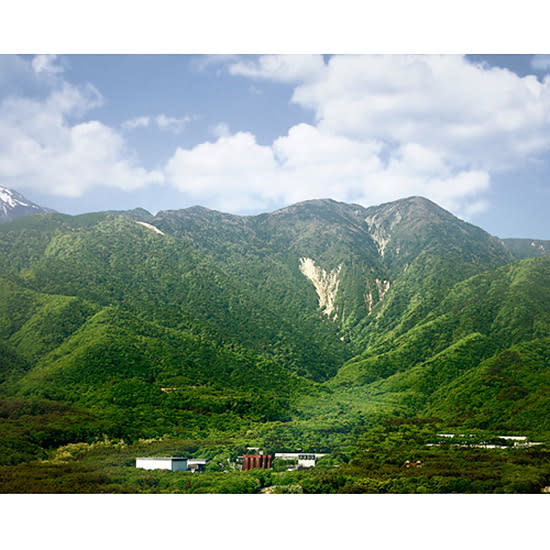Where to Eat, Drink, and Stay in Japan's Stunning Yamanashi Wine Region
Drive into the town of Katsunuma, in Japan’s Yamanashi Prefecture, and you might not realize that you’re entering one of Asia’s best-known wine-producing regions. Instead of the rolling hills striped with vines you’d see in European or New World wine regions, the town is full of tiny vineyards sandwiched between houses, or growing side-by-side with peach, apple, and kiwi orchards. These tiny growing plots are common in Japan; thanks to the way land was historically divided, individual fields can be very small, and a farmer might have a handful of noncontiguous plots scattered around a community.
Many of the grapes here are also grown in a regionally specific way: The vines reach high above the ground and are trained on tall, flat pergolas so that growers can walk underneath them. This keeps the grapes far from the ground (which is often muddy in the summer and can invite disease), shades them from the region’s high temperatures, and allows more air to flow around each bunch to counteract the intense humidity. The method also increases the yield per square meter, which is useful in these small plots and is also considered beneficial for local varietals like koshu, a grape that makes a very thin, light-flavored white wine.

In other parts of the prefecture, vineyards look a little more familiar to the Western eye. At Domaine Mie Ikeno, a buzzy winery owned by the country’s best-known female winemaker, parallel rows of vines run up to the top of a hill with a stunning view of snow-capped Mt. Fuji.
A post shared by Domaine Mie Ikeno 【2019仕込み中〜♪】 (@domainemieikeno) on Dec 5, 2019 at 10:30pm PST
But walk through the field in summer, and the ground is still squishy with rain. Abundant grass between the rows hides all manner of insects, and the air is so thick with butterflies that Ikeno brushes them away like pests. Ikeno’s vines are also trained high off the ground, and long strips of plastic running along each row protect the bottom-most grapes.
While Yamanashi has started to gain recognition as a wine region, it is still largely unknown to foreigners, and it can be difficult to navigate on your own. The region is relatively large, encompassing 1,723 square miles to the west of Tokyo Prefecture, and includes numerous cities, towns, and sub-regions. Wineries can be hours apart, and very few actually offer tasting rooms for visitors. Those that do, however, offer an experience that is a unique combination of Japanese and Western culture, with procedures and etiquette from traditional French wineries and tasting rooms adapted to suit local tastes.
Some wineries are built in a traditional Japanese style, with sliding screens and tatami mats, while others create a faux-European feel to give visitors a sense that they’ve stepped out of Japan for a day. At Risonare Yatsugatake, one of the area’s largest resorts, restaurants are laid out along a walking street designed to look like an idealized version of a French town with farm stands along the sides.
RELATED: The Time to Visit Japanese Wine Country Is Now
Many of the wines produced here are also unlike those found in European or New World regions. Developed to appeal to local drinkers and pair well with Japanese food, Yamanashi’s wines can be much leaner and lighter than their European and New World counterparts, and tasting notes reference flavors more familiar to the Japanese palate, like black tea or roses. Some have unusual flavors notes, like Vaseline or a touch of salty soy sauce. Some are more robust, meant to pair with strong dishes or ingredients like uni. Other wines take their queues from the Old World and offer more familiar flavors.
After a couple days of tasting wines from various Yamanashi wineries, one thing becomes clear: the region is full of surprises, and no one style defines its wines.
Where to Taste Yamanashi’s Wines

Risonare Yatsugatake Wine House
For an introduction to Yamanashi’s wines, head to this tasting room inside a wine-themed resort. Part of a small wine shop, this tasting room offers a variety of wines from across the region—including many from small vineyards that don’t have their own tasting rooms. Highlights include the chardonnay, pinot noir, and merlots from Domaine Mie Ikeno, which has a partnership with the resort.
The oldest winery in Japan, Marufuji was first opened in 1890 by the Omura family, which continues to run it four generations later. This is the place to get a sense of how wines are geared toward the local palate and designed to pair with delicate local foods. The hushed tasting room is located in a traditional Japanese-style wood-framed house and offers a variety wines, from koshu to petit verdot.
Grace Vineyard is one the most famous wineries in the Yamanashi and has won international awards for its koshu. The tasting room is located at the winery, in a concrete building almost completely blanketed in ivy, on a city street in Koshu. Tastings take place in their second-floor wine shop.
Château Mercian Katsunuma Winery
This winery is one of the largest and best known in the region. Mercian is popular for its Bordeaux-style reds, merlots, and chardonnays, as well as for its many different koshus. The boxy, modern winery offers a variety of tours and tastings, all of which fill up quickly and must be booked at least two days in advance of a visit.
This small, family-run vineyard offers a more relaxed and intimate tasting experience. Proprietor Yasunobu Komaki, a sommelier who worked at the renowned Imperial Hotel for three decades, offers reservation-only tastings in the shade of a small grove of birch trees, as well as the option to book lunch (prepared by his wife) or even stay overnight in a comfortable yurt. As one might expect from a sommelier who worked in an international hotel for decades, Komaki’s wines are strikingly well-balanced and appealing to a Western palate.
Where to Eat
When the renowned Tokyo restaurant Aoyama Esaki lost its third Michelin star in 2017, it relocated to Yatsugatake. The tiny new restaurant offers just a few reservations (for both lunch and dinner) and a set menu full of the seasonal, modern Japanese dishes that highlight local produce and seafood.
Izutsuya
This restaurant in the town of Hokuto is housed in a 1927 building that was a confectionary shop before WWII. Today, this is the place to go for eel rice bowls, and it is popular enough that locals recommend making a reservation at least one day in advance.
This relaxed lunch spot offers Western-style food in a sunny dining room overlooking the restaurant’s own vegetable fields. Options include a few kinds of pizza and the “Harvest Plate,” an assortment of salads, some pasta, a mini quiche, a cup of soup, and a small serving of meat or fish.
Where to Stay

This wine-themed resort offers tastings, wine classes (in Japanese), wine-focused spa treatments, and a Western-style restaurant with a large cellar that boasts a particularly good collection of Japanese wines. The resort also offers kid-friendly outdoor activities, access to nearby ski runs, and an enormous swimming pool.
Offering sweeping views of Mt. Fuji, the cozy property features open-air natural hot spring baths lined with volcanic stone from the famous mountain itself, with a restaurant serving kaiseki cuisine made with regional Kawaguchiko ingredients and wines from the Yamanashi Prefecture. While further away from many of the wineries than Risonare Yatsugatake, it's perfectly situated to weave Mt. Fuji into your trip, whether at the beginning or end.
Other Local Specialties

Yamanashi Prefecture is also known for its whiskies, and one of Suntory’s largest distilleries is located here. You’ll need to make a reservation at least a day before your visit, regardless of whether you want a guided tour of the facilities or just plant to see the on-site museum and enjoy a drink at the bar. Distillery tours offer the rare chance to taste the component whiskeys used to make the company’s acclaimed single malt.
Kikyouya Confectionary
Stop by this venerable sweet shop, which has been open since the Meiji period, to pick up some non-alcoholic souvenirs. The shop invented shingen-mochi, a type of sweet mochi rice cake topped with roasted soybean flour and drizzled with brown sugar syrup. It also sells shingen momo, a peach-shaped baked bun filled with a mixture of white bean jam and jelly made from flavorful local peaches.

